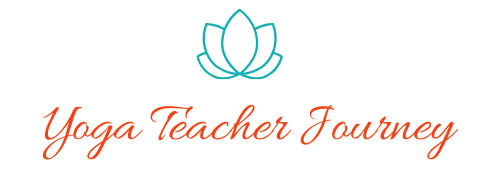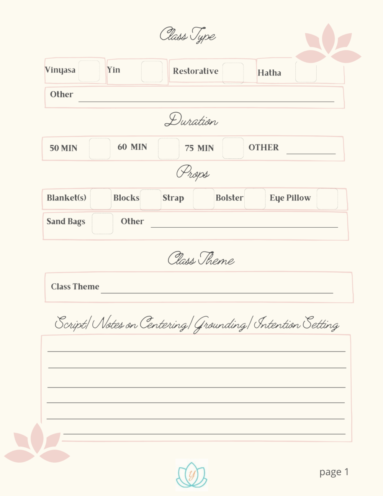Themes? I’m not even sure that word came up in our teacher training. Well, maybe it did. It certainly wasn’t something we focused on or spent any serious time discussing. And honestly, in my opinion, it can be one of the most difficult aspects of planning and teaching a class.
You’ll most likely want to theme your classes and provide a complete and memorable experience for your students. It gives students SOMETHING intentional to focus on. To keep them engaged. To take them away from the stress of their own worries and monkey brain thoughts and bring them to the here and now (here’s something to focus on right now!). It can be meditative! It can be educational! Choose a topic: an emotion, a moon phase, one of the eight limbs of yoga, a yoga sutra, or something from yoga philosophy, a chakra, a season, a holiday, something relevant in current events, mindfulness, presence, stillness, places you hold stress, letting go, the struggle, (see more detailed theme suggestions below) – and then go with it!
So how do you choose what to theme your class around and then of course how DO you actually theme a class?
The good news is that you really have lots of options and ways to do this; the bad news is that it’s not that simple.
At least in my opinion. There have been many books written on the subject of theming classes (I’ve shared a few below); however, the best themes are ones you feel a strong connection to. I mentioned the Yoga Sutras [of Patanjali] above, which you should have read as part of your training. Do you have a favorite sutra? Something that spoke to you? Of the 8 limbs of Yoga, is there a particular limb or perhaps a Yama or Niyama that you connect with more than others? These are great places to start. A favorite quote that moves you? There are many, many places to find inspiration for themes. The trick is in order for it to be meaningful to your students, it must be meaningful to you too. If you’re not feeling it, it won’t feel authentic to the students. This is the hardest part of theming classes. You’re not always going to feel it; but you’ll want to do your best to make that happen. Check out my new Themes & Sequences Workbook to see if you connect with any of the twenty themes provided there!
The very first theme I did was on embracing change. I was taking over someone’s class who had been teaching the same group of students for years – and then here I come. I was a brand new teacher trying my best not to let them see how nervous I was and to begin our journey with something meaningful. So I chose Embracing Change. It was heartfelt because I was going through this change too. Change is not easy. We all fear and resist change that’s brought about by others because we are comfortable with the way things are. We hold on to what is familiar and naturally choose to stay inside our comfort zone. The fear is in the unknown. This is why we’re here now talking about this subject because it is something new – a change – that you will need to become comfortable with in order to feel confident!
Confidence is extremely important for teachers, new and experienced, because that confidence will transfer to your students. We want to provide a safe, calm, relaxed atmosphere so that when they enter your class they will feel relaxed in the space you are holding for them and they are able to achieve their goal of yoga.
Can you imagine (or maybe you’ve had this experience), entering a yoga studio and seeing your instructor looking uneasy, lacking confidence, nervous and uptight? How would that make you feel? Exactly. For this reason, I recommend practicing your theme. Reading it, reciting it, and using it while you practice your sequence to see where those interjected words of wisdom fit best.
Once you have chosen a theme:
- How are you going to present this idea to students?
- How are you going to weave it into your sequence?
- How are you going to wrap it all up?
Start brainstorming and write a little about your theme. I like the idea of using a yoga sutra or quote when starting out because you’ve been given a head start. You can read the quote to them, then, in your own words, tell the students your interpretation or what it means to you.
I present my theme to students while they are in their centering or intention setting posture. I recommend as a new teacher starting students in a relaxed position on their backs for each class if possible. Not only do I love starting class this way myself as a student, but as a new teacher, you won’t feel that students are watching you especially if you’re reading. I usually cue them into relaxing and a pranayama exercise (I like Dirga breath) and then while they are engaged in breathing, present the theme.
Here is an example theme from my teaching experience mentioned above – fall 2018:
We’re talking about change this week; life is about changes. Weather changes, seasons change; people come in and out of our lives causing changes. We naturally resist change when it is brought about by others because it is out of our control and unknown. The one constant we can rely on and turn to during these times, is inside of each of us: our true inner self. Connecting to that place, we have control, and can find calm and inner peace.
As you begin to notice your breath, set an intention for your practice today. Maybe it’s to be open to a new practice, or to allow yourself to go inside and find peace during this change, or just to be present in this moment…. because all you are really doing in this moment is breathing in and breathing out. Use that breath to ground you, to be an anchor to bring you back when your thoughts take control, to help you navigate and embrace change. Allow your breath to return to its natural rhythm…
During the practice you will want to return to your theme a couple times to help keep students connected and mindful of your theme. You’ll decide the best places to insert the reminders.
What changes are you feeling in this posture? In this practice? Remember to return to your breath when needed. Using it as your anchor to help you navigate and embrace this change.
In addition to an active pose, I like to use the time that they’re in child’s pose (balasana) maybe later in the practice, to remind them of the theme. Here they are drawing their awareness inside once again and it is a good time to reinforce your theme.
While you connect to your breath here, maybe reflect on how you felt coming to this new practice today, and how it may feel more comfortable to you now. On your next exhale, relax more deeply into this comfortable space.
Then, either as they are getting into final relaxation pose (savasana), or coming out of it, provide some sort of closing that refers back to your theme:
Give yourself gratitude for coming to your mat today, and being open to a new practice, a new way to move your body, and new way to embrace change…
It takes some preplanning to design your themed class. If you are using an anatomical theme – for example, relieving stress in the shoulders – then you might need to spend more time reinforcing your theme during the asanas that specifically relate to relieving stress in the shoulders.
I recently finished a chakra themed series of classes for the first time. I’ve done specific chakras before but not a full series of classes focusing on a chakra each week from root to crown (Muladhara to Sahasrara). This was actually great fun, AND I had seven weeks of themes already chosen! For the final week, the crown chakra (which I think is the most difficult to link postures to) I chose to end with a guided meditation that allowed students to revisit all the chakras and lastly “…feel the peace that comes with noticing the energy in this chakra and the connection to the divine.”

Keep your themes! File them away, either electronically on your computer (this is what I do), or otherwise (handwritten) so you can reference them at a later time and reuse them. Don’t worry about repeating themes. It is good for students to hear the material more than once. It will help to reinforce what you are teaching. Repetition is a good thing. I’m sure there are many aspects of your class that you repeat in each class. Just record yourself once and you’ll pick-up on those little phrases that you tend to repeat. Again, this is a good thing and helps provide a level of comfort to students.
It’s also wise to have a default theme! Something pretty generic and that you have memorized, that’s easy to pull out of your mental library and use just in case you are in a bind. This could happen if something major comes up in your life and you just don’t have time to plan ahead. My generic theme is Present Moment. “…focusing on the breath to bring you back to the present moment. Acknowledging thoughts and allowing them to drift through your awareness. Using your breath as an anchor to help bring you back to the present moment, etc.…”
In conclusion and as promised, here is a list of themes, and scroll down a little further for a list of resources to read more about theming your classes and for inspiration.
Theme Topic Ideas
Yoga Sutra 1:2
Yoga Sutra 3:30
Yoga Sutra 4:15
Yoga Sutra 2:5
Any of the Yoga Sutras that Speak to You
Dharana (Focus, Concentration or any of the 8 Limbs of Yoga)
Ahimsa (or Any of the Yamas or Niyamas)
Drishti (Gaze, Focus or as it relates to Pratyahara or Dharana)
Your Center
Your Body Will Guide You
Love Yourself and Relax
Stillness
You are a Balance of Yin and Yang
Letting Go
Self-Care
The Journey
State of Calm – Parasympathetic Nervous System
Be Present in This Moment
What’s Right Within You
Your Favorite Things
Freedom from Attachment
Journaling
Overcoming Obstacles
Freedom – Independence Day
Creating Space
Letting Go of Feeling Overwhelmed
Presence
Intention (Sankalpa)
Sangha (Community)
Santosha (Contentment)
Dharma (Life’s Purpose)
Loving Kindness/Compassion
Gratitude
Staying Grounded
Detoxing the Mind
The Senses
Embracing Change
Summer Solstice
Fall Equinox
Lunar Eclipse
New Moon
Struggle to Grow
Mother’s Day – Nurturing
Father’s Day – Strength
Labor Day – Hard Work
Letting Go of What’s No Longer Serving You
Open Heart
Inner Peace
Abundance
All or any 7 of the Chakras:
Muladhara (Root Chakra)
Svadhistana (Sacral Chakra)
Manipura (Solar Plexus Chakra)
Anahata (Heart Chakra)
Vishuddha (Throat Chakra)
Ajna (Third Eye Chakra)
Sahasrara (Crown Chakra)
Inspiration for some of the themes above came from the resources listed below.
The Inspired Yoga Teacher by Gabrielle Harris
Teaching Yoga Beyond the Poses by Sage Rountree and Alexandra Desiato
Theme Weaver: Connect to the Power of Inspiration to Teaching Yoga by Michelle Berman Marchildon
The Yoga Sutras of Patanjali by Sri Swami Satchidananda
The Yamas and the Niyamas by Deborah Adele





